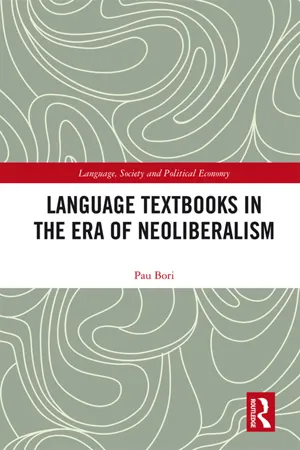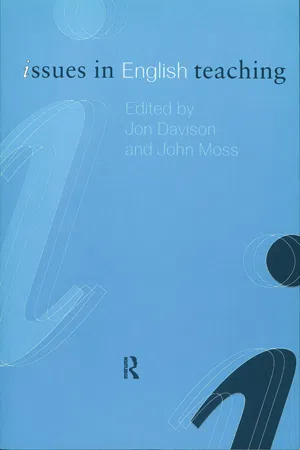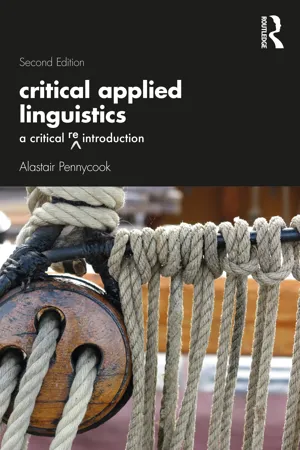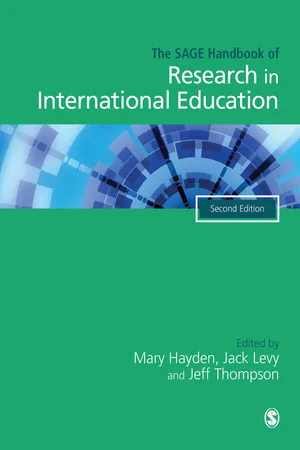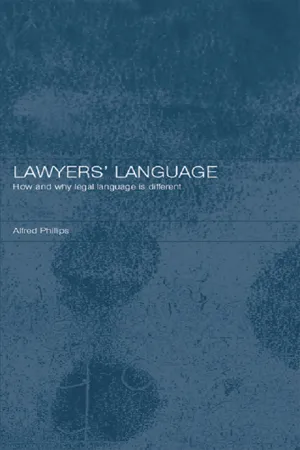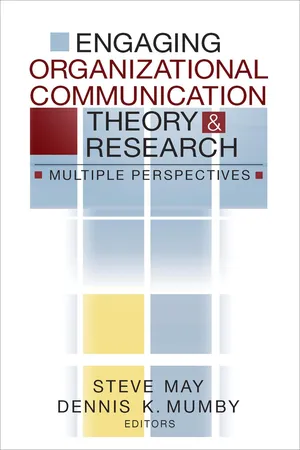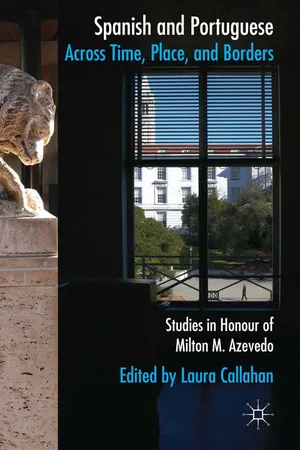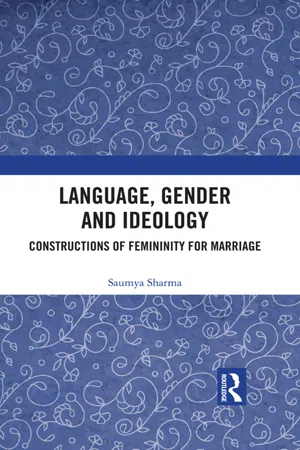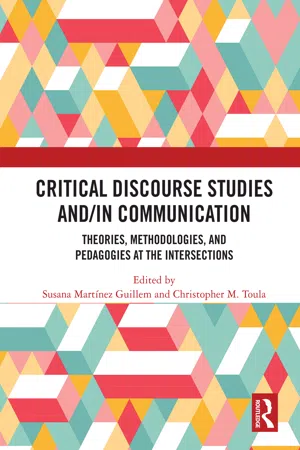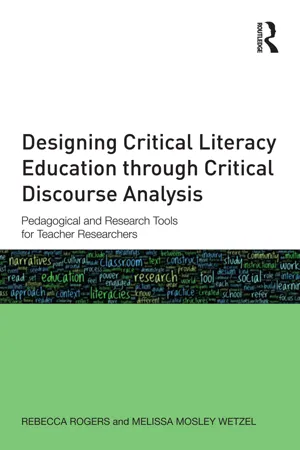Languages & Linguistics
Critical Theory
Critical Theory is a philosophical approach that seeks to understand and critique society and culture, aiming to identify and challenge power structures and inequalities. In the context of languages and linguistics, Critical Theory can be applied to analyze how language is used to perpetuate or challenge social norms and power dynamics, and to explore the relationship between language and power.
Written by Perlego with AI-assistance
Related key terms
12 Key excerpts on "Critical Theory"
- eBook - ePub
- Pau Bori(Author)
- 2018(Publication Date)
- Routledge(Publisher)
3 Critical research on language textbooksIntroduction
This chapter explores how critical studies related to foreign/second language textbooks have evolved during the past four decades. Critical approaches draw on the idea that we live in a world in which our circumstances are conditioned by aspects such as social class, race, ethnicity, gender, sexuality or economic and geopolitical situations (Canagarajah 2005). They aim to identify, analyze or subvert different kinds of discrimination. One of the key aspects of critical work is “turning a skeptical eye toward assumptions, ideas that have become ‘naturalized’, notions that are no longer questioned” (Pennycook 2001: 6). Critical movements in applied linguistics borrow conceptual frames from other disciplines such as anthropology, sociology, economics, psychology or cultural studies, and are primarily centered on the relationship between power and language use. Many different approaches in applied linguistics bear the name ‘critical’ such as critical discourse analysis (or more recently, critical discourse studies), critical applied linguistics, critical literacy, critical sociolinguistics, and so on (see Pennycook 2010 for a review). Others, however, do not include the prefix ‘critical’ in their names, but draw on insights from theories and movements such as feminism, anti-racism or Marxism, that are critical by definition since they examine questions related to inequality or discrimination with the goal of transforming reality.Generally speaking, when it comes to studies of language materials, the objective behind critical research is to identify, analyze and critique injustices or partial views generated by power structures in societies that appear in textbooks and in that way contribute to the battle to overcome social inequalities. Materials for learning additional languages first became the object of studies in the 1970s, at a time when English was gaining momentum as the international lingua franca - eBook - ePub
- Jon Davison, John Moss(Authors)
- 2002(Publication Date)
- Routledge(Publisher)
13 How Should Critical Theory Inform English Teaching? John Moss IntroductionFor the purposes of this chapter, Critical Theory will be described as a set of perspectives on, or configurations of, relationships among writer(s), text(s) and reader(s), which may or may not take account of: aspects of the context(s) of those relationships; the significance of other texts to them; and the systems within which readings are produced (see Figure 13.1 ).Individual theories, or perspectives on this set of relationships, may pay most attention to one or more of the following areas:Figure 13.1 Elements contributing to the meaning(s) of reading(s)1 choices of text, and how one text relates to another; 2 writers: who they are and what they do; 3 texts, and how they work; 4 readers: who they are and what they do; 5 the social, historical and cultural contexts in which texts are produced and received; 6 the systems in the operation of which the location of the authority for meaning is determined.The emphasis that a theory places on one or more of these areas tends to be related to the author’s view of the location of an authority for meaning, and whether that lies primarily in:- tradition and culture;
- the writer’s intention or psychology;
- the meaning inherent in the text or that can be derived from its procedures;
- the process of reading as it represents the text or the reader’s identity; or
- the influence of social and historical factors on the areas that writing and reading practices include or omit.
This chapter needs a means of grouping theories for the purpose of discussing how different types of theory should inform the English curriculum. In Figure 13.2 - eBook - ePub
Critical Applied Linguistics
A Critical Re-Introduction
- Alastair Pennycook(Author)
- 2021(Publication Date)
- Routledge(Publisher)
structure – as an enclosed system within which we conduct our analyses – this does not mean that it cannot therefore deal with, for example, structural racism. The point of the idea (as with other forms of structural discrimination) is that this is not about individuals and their views but a question of institutions, social formations, ideologies, discourses, and so on. We may get at deep-seated forms of discrimination and inequality in different ways, but all critical standpoints view such concerns in systemic terms, whether we look at practices (as sedimented social action), discourses (as formations of power and knowledge), ideologies (as ideas formulated in the interests of the powerful), institutions (as social formations that structure society), or northern epistemologies (as ways the Global North systematically excludes the Global South). These are different perspectives but they all seek to get beyond individualistic and liberal accounts of choice, freedom, and the individual. As Marx (1852, p. 1) famously put it, people “make their own history, but they do not make it as they please; they do not make it under self-selected circumstances, but under circumstances existing already, given and transmitted from the past.”As we pursue different domains – the politics of language, difference, text, and pedagogy – in the following chapters, the greater complexity of different intersecting critical domains will become more apparent. I have attempted in this chapter, in rather compressed and simplified form, to sketch out various configurations of how language and politics may be related. The key question is not whether applied linguistics is political but about how it should be critical. In Chapters 3 to 6 - Mary Hayden, Jack Levy, Jeff Thompson, Mary Hayden, Jack Levy, Jeff Thompson(Authors)
- 2015(Publication Date)
- SAGE Publications Ltd(Publisher)
Although as an educator I certainly do not wish to undervalue the mainstream approach to critical analysis, I believe that to attain a fuller awareness of how language operates in its social environment it is also necessary to engage with the more politicized versions. The literature I discuss later in this chapter is informed primarily by these versions, with a particular emphasis on postcolonial critique.Critical paradigms have influenced a range of academic fields concerned with language and culture, including applied linguistics (Block et al., 2012; Canagarajah, 1999; Kubota, 2001; Pennycook, 2001; Tollefson, 2002), literacies (Morgan, 1997; Street, 1995), bilingualism (Walsh, 1991: 127), intercultural awareness (Guilherme, 2002), multiculturalism (Kubota, 2004), social psychology (Ibanez and Iniguez, 1997) and ethnography (Carspecken, 1996). Researchers explore the links between linguistic practices, the construction of identities and the representation of social groups. They argue that language is never neutral; that it is never value-free; that it is always the product of some culture, whether this is institutional, professional, national and so on. Language is always written or spoken from a particular ideological perspective, regardless of whether the writers or speakers are aware of their biases (Caldas-Coulthard and Coulthard, 1996; Fairclough, 2014; Gee, 1996; Howarth, 2000; Pennycook, 1994a; Wodak and Meyer, 2001).With regard to practical applications, the findings of research have led to the development of critical language pedagogies (Benesch, 2001; Brutt-Griffler and Samimy, 1999; Norton and Toohey, 2004; Pennycook, 1994a; Phipps, 2004; Phipps and Guilherme, 2003). These relate to an older, broader tradition of critical pedagogy, which challenges dominant ideologies by promoting radical modes of education (Freire, 1984; Giroux, 1992).The second key term that we need to consider is discourse. While definitions of this term also vary, the following encapsulates some of the key features:A discourse refers to a set of meanings, metaphors, representations, images, stories, statements and so on that in some way together produce a particular creation of events. It refers to a particular picture that is painted of an event (or person or class of persons), a particular way of representing it or them in a certain light. (Burr, 1995: 48)- eBook - ePub
Lawyers' Language
The Distinctiveness of Legal Language
- Alfred Phillips(Author)
- 2003(Publication Date)
- Routledge(Publisher)
Driven as social beings to communicate, unless we believe in the powers of telepathy, we are stuck with language, warts and all. In formulating their critique, even the exponents of critical linguistics have no option but to make use of language. The instrument (language) employed for the analysis is identical with the object of the analysis itself (language). So, in constructing its Critical Theory, critical linguistics cannot but build a trap for itself. Later in the chapter, the review of deconstructionism and of the position of ideology in neo-Marxist thought, with their threats to the integrity of the legal text, reveals a mechanism whereby each seeks to escape its own trap. Rhetoric It is an imperative to look closely at rhetoric as an introduction or background to critical linguistics, at least in relation to law. Perhaps even, in its own terms, rhetoric is to be regarded as the umbrella term covering critical linguistics. Rhetoric is classically defined as the art of persuasion by discourse, discourse in this context being used in its non-technical sense. Speech or argument, therefore, is to be measured not by whether it is true, valid or sincere but by whether it is effective in persuading those to whom it is addressed. The elimination of the dimension of referentiality intrinsic to language, common to the other theories to be discussed here, emerges clearly in the definition. To call rhetoric an art inevitably imports the many facets of an art: a study or a legitimising discourse; a set of practices or techniques; and along with these a nuance of art fulness. Nowadays, in ordinary usage, we pick up two of these aspects in the phrases: ‘rhetorical question’ and ‘mere rhetoric’ - eBook - ePub
Engaging Organizational Communication Theory and Research
Multiple Perspectives
- Steve May, Dennis K. Mumby(Authors)
- 2004(Publication Date)
- SAGE Publications, Inc(Publisher)
Power and authority act differently on different people partly by situation but also partly in how power is framed or encountered. Enlightenment and conceptual tools, as well as radical action, can change our choices and power to act. A critical theorist holds out hope that power/authority relations can be at least momentarily transcended or partly set aside for a more productive interaction, all the while not forgetting about power differences and how sneaky and intrusive they are. With this hope come efforts to create communicative contexts where power is suspended or held in check so that more creative and representative decisions can be made (Deetz & Simpson, 2004). Some of the critical work has focused almost exclusively on how such safe, democratic places can be created (Deetz & Brown, 2004; Forester, 1989, 1999; Zoller, 2000).The Emergence of Critical Theory in Organizational Studies
Critical theorists position their work in regard to four specific developments in Western thought. The way they respond to and partly use mixes of these developments accounts for many of their differences. These developments are (a) the power/knowledge relation arising with Friedrich Nietzsche’s perspectivalism; (b) a nondualistic, constructionist account of experience and language arising with phenomenological hermeneutics and structural linguistics; (c) a historically based social conflict theory arising from Karl Marx; and (d) a complex human subject arising from Sigmund Freud.The first posed a challenge to any possible foundations for knowledge located in the external world: All knowledge claims are relational, referencing social communities filled with specific power relations and processes of knowledge production rather than simply representing an essential external world. The second situated all perspectives within specific social/historical/linguistic contexts; intersubjectivity precedes any subjectivity or objectivity as structured in specifiable ways. The third removed the innocence of social/historical/linguistic perspectives by positioning them within materially produced social divisions and denied any smooth unitary historical development. The fourth provided for a complex, conflict-ridden, and often mistaken subject in place of a knowing, unitary, autonomous person - eBook - ePub
Spanish and Portuguese across Time, Place, and Borders
Studies in Honour of Milton M. Azevedo
- L. Callahan(Author)
- 2015(Publication Date)
- Palgrave Macmillan(Publisher)
Discourse and Social Change . Cambridge: Polity.———. 1995. Critical Discourse Analysis: The Critical Study of Language . New York: Longman.———. 2002. Language in new capitalism. Discourse & Society . 13-2: 163–6.Foucault, Michel. 1972. The Archeology of Knowledge and the Discourse on Language . A. M. Sheridan Smith, trans. New York: Pantheon Books.———. 1973. The Birth of the Clinic: An Archeology of Medical Perception . A. M. Sheridan Smith, trans. New York: Routledge.———. 1980. Power/Knowledge: Selected Interviews and Other Writings 1972–1977 . Colin Gordon, ed. New York: Pantheon.Gal, Susan and Kathryn A. Woolard. 1995. Constructing languages and publics: Authority and representation. Pragmatics . 5-2: 129–38.Gershon, Ilana. 2010. Media ideologies: An introduction. Journal of Linguistic Anthropology . 20-2: 283–93.Gumperz, John J. and Jenny Gumperz-Cook. 2008. Studying language, culture, and society: Sociolinguistics or linguistic anthropology? Journal of Sociolinguistics . 12-4: 532–45.Harris, Zellig S. 1952. Discourse analysis. Language: Journal of the Linguistic Society of America . 28-1: 1–30.Heller, Monica. 2008. Language and the nation-state: Challenges to sociolinguistic theory and practice. Journal of Sociolinguistics . 12-4: 504–24.Heller, Monica and Alexandre Duchêne. 2007. Discourses of endangerment: Sociolinguistics, globalization and social order. In Monica Heller and Alexandre Duchêne, eds. Discourses of Endangerment: Ideology and Interest in the Defense of Languages . New York: Continuum. 1–13.Hodge, Robert and Gunther Kress. 1993. Language as Ideology . 2nd edn. London: Routledge.Hymes, Dell. 2000. The emergence of sociolinguistics: A response to Samarin. Journal of Sociolinguistics . 4-2: 312–15.Kroskrity, Paul V. 2000. Regimenting languages: Language ideological perspectives. In Paul V. Kroskrity, ed. Regimes of Language: Ideologies, Polities, and Identities . Santa Fe, NM: School of American Research Press. 1–34.———. 2009. Narrative reproductions: Ideologies of storytelling, authoritative words, and generic regimentation in the village of Tewa. Journal of Linguistic Anthropology - eBook - ePub
Advocacy Research in Literacy Education
Seeking Higher Ground
- Meredith Rogers Cherland, Helen Harper(Authors)
- 2023(Publication Date)
- Routledge(Publisher)
Both psychology and sociolinguistics had “stopped short of theorising or analysing adequately the social and discursive histories and forces which influence what reading is made to be, how reading is done, for students in schools” (Baker & Luke, 1991, xiv). Baker and Luke argued that framing sociolinguistic analysis with critical theories of knowledge and cultural transmission, of discourse, and of cultural and economic reproduction would illuminate how school reading constitutes readers, and also works to constitute society. Fairclough (1992) also credited important developments in “critical linguistics” research at the University of East Anglia during the 1980s, specifically the work of Fowler, Kress and Hodge, which centered on the ideological analysis of the grammatical and vocabulary features of written texts. This work involved a critical orientation to language study that refused to take language conventions and practices at face value, and refused to ignore their political investments. Bourdieu (1991), Habermas (1979), and Foucault (1980) were all important influences on this work, and critical discourse analysis continued to develop. Unlike sociolinguistic research, CDA did not stop with detailed linguistic analysis of language in use in local sites. It began there, but then went on to follow Foucault by linking the local to a broader analysis of discourse and power. Example Studies Allan Luke’s (1992) study of literacy events in an Australian Grade One classroom provides an early example of critical discourse analysis that makes careful and productive use of both poststructural theory (specifically, Foucault’s discourse theory) and neomarxist theory (specifically, the critical sociology of Pierre Bourdieu) to demonstrate the ways in which literacy events construct and position the literate child through the discourses of pedagogy - eBook - ePub
Language, Gender and Ideology
Constructions of Femininity for Marriage
- Saumya Sharma(Author)
- 2018(Publication Date)
- Routledge India(Publisher)
The fundamental idea was that the texts contained some kind of “signification in social structure” (Fowler et al. 1979: 96), which could be understood from three basic assumptions. Any linguistic process in a text could be analysed in relation to one of the three functions (ideational, interpersonal and textual) of language given by Halliday; a systematic analysis of what occurs in speech or writing is dependent on social rules, the choices made by the participants and their purposes, and that meanings are syntactically embedded in texts, hence analysis required decoding these meanings to understand the social relations of power and ideology through the texts. Critical linguists did not claim that an analysis of society could be done solely through an analysis of language but that language was one of the focal points for analysis, for it was thoroughly a social phenomenon. Ideological representation and power dynamics could also be seen through material practices of social institutions, and this aspect was later included in Fairclough’s arguments in CDA. Moreover, a critical linguistic analysis was considered an interpretative exercise that could be conducted by critical examiners unlike the uncritical masses who were conditioned by social norms to think and behave in particular ways (Fowler et al. 1979). Thus, the critic’s evaluation was favoured, and a dichotomy was created which is also broadly implicit in most of CDA. In fact, CDA works on an avowedly political stance, championing the cause of the oppressed, yet it assumes a simple unproblematic relationship between the text and reader. The issue of readers’ responses is largely not given attention in CDA (Breeze 2011), and that is why there is a need to examine the responses, for they will reveal the ways in which media affects individuals, whether they support, resist or question social beliefs and to what extent their views are similar to that of the critical analyst.Interdisciplinarity and goals
Teun van Dijk (1985b) is of the view that during the 1960s and 1970s, many disciplines such as pragmatics, text linguistics, anthropology, semiotics, narratology, literary criticism and sociolinguistics led to the emergence of a distinct discipline called discourse analysis/discourse studies. Van Dijk (2008) asserts that discourse studies has a lot in common with CDS because they are both interested in examining language in the following ways: - eBook - ePub
Critical Discourse Studies and/in Communication
Theories, Methodologies, and Pedagogies at the Intersections
- Susana Martínez Guillem, Christopher Toula, Susana Martínez Guillem, Christopher M. Toula(Authors)
- 2020(Publication Date)
- Routledge(Publisher)
and beyond—that, informed by critical humanism, places the struggle for more equal societies,as well as the(limited)role of the critic in this project,at the fore-front of inquiry. Thus, whereas in CDS literature, the debates surrounding issues such as reflexivity, critique, or the mediated relationship between texts and objects are relatively recent, many scholars in communication studies have been historically attuned to the triple crisis “in representation, legitimation, and praxis,” and the consequent need to acknowledge the fundamental ways “the self”—researcher, reader, speaker—shapes knowledge. 32 Although with different emphases, both bodies of scholarship are thus suit-able partners in a perspective that emphasizes“language as activity,”as well as the“history of language” 33 in its quest to account for the intrinsic, contradictory, and multilayered relationships between societal dispositions and specific discursive practices. 34 Despite their a priori philosophical compatibilities, one of the main obstacles disconnecting the trajectories of CDS and these critical perspectives in communication studies stems from the perceived tension between method-driven analysis, and theory-driven critique - eBook - ePub
Designing Critical Literacy Education through Critical Discourse Analysis
Pedagogical and Research Tools for Teacher-Researchers
- Rebecca Rogers, Melissa Mosley Wetzel(Authors)
- 2013(Publication Date)
- Routledge(Publisher)
(Hopson, 2003, pp. 234–235)Our intention was to link language to historical and structural contexts, to situate language issues alongside concerns such as domination and conflict and to foreground how these matters are the concern of literacy teachers. Over the course of two months, the students participated in a number of in-class and out-of-class activities designed to deepen their knowledge of linguistic diversity. Students researched multilingualism and presented their learning to peers in class. They formed a language committee charged with crafting a letter to Dr. Marie Clay, 1 a researcher who developed such tools as the Observation Survey of Early Literacy Development (Clay, 1993) and the reading intervention Reading Recovery: A Guide Book for Teachers in Training (Clay, 1994). They inquired about recording linguistic diversity in running records in their letter. Several of the books the students chose for their end of the semester book clubs focused on multilingualism (e.g., Purcell-Gates, 1995; Schwartzer, 2001). What was particularly exciting about this slice of our classroom life was that, in many ways, our students were leading the charge with inquiry into language and power. This chapter, like all the rest, dually focuses on how they critically analyzed and used language and also our analysis of their learning. Along the way we demonstrate an approach to critical discourse analysis that draws on building tasks and inquiry models to understand social practices (Gee, 2010).The Building Tasks Analysis
Traditions and Concepts
Gee's tradition of discourse analysis, referred to as a “building tasks” analysis, draws on American anthropological linguistics, social discourse theories, and cognitive psychology. As we discussed in Chapter 1 - eBook - ePub
Philology and Global English Studies
Retracings
- Suman Gupta(Author)
- 2015(Publication Date)
- Palgrave Macmillan(Publisher)
3). It seems a supererogatory qualification, offered as if to protect the territory of linguistics from literary critical infringements. Similar sorts of equivocations could be found in Michael Toolan’s Narrative (1988), also describing literary texts as marked by distinctive literary language – the province of stylistics – while simultaneously extending the linguistic apprehension of stylistics beyond literary texts (in a chapter on newspaper reports). Fowler’s articulation of social discourse and critical linguistics through the literary, with a gradual drawing away from the literary, and with a hardening of the delimitation of the literary as a certain kind of object (defined by stylistics), gradually led to the removal of the literary from linguistic discourse analysis and absorption of the social into linguistics at the expense of the literary. The gathering together of linguistic discourse analysis as a disciplinary area, drawing together various strands of specialized linguistic studies into the coherent shape, was already underway by then. This was apparent in textbook-like overviews of linguistic discourse analysis of the time. The Political Desire of Discourse Analysis Early textbook-like accounts of linguistic discourse analysis (effectively drawing together and institutionalizing the field) – such as Malcolm Coulthard’s An Introduction to Discourse Analysis (1977, 2nd ed. 1985) and Michael Stubbs’s Discourse Analysis (1983) – usefully put the above debates into perspective. These established methodological continuity for discourse analysis with the descriptive thrust of linguistics, and, in the same move, argued the inevitability of some degree of engagement with the social therein. The impulse, these observed, of discourse analysis is the same as that of mainstream linguistics for much of the twentieth century: description of living language in language itself/specific languages
Index pages curate the most relevant extracts from our library of academic textbooks. They’ve been created using an in-house natural language model (NLM), each adding context and meaning to key research topics.
